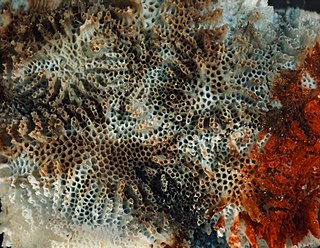
This is a list of members of the 4th Reichstag – the parliament of the Weimar Republic, whose members were elected in the 1928 federal election and served in office from 1928 until its dissolution in 1930.

General der Panzertruppe was a General of the branch OF8 rank of the German Army, introduced in 1935. A General der Panzertruppe was a Lieutenant General, above Major General (Generalleutnant), commanding a Panzer corps.

Gwladys Street's Hall of Fame celebrates the men who have contributed to the history of English football club Everton. Everton's ground, Goodison Park, is on Gwladys Street in Walton, Liverpool.
Members of the Bavarian Maximilian Order for Science and Art, awarded to acknowledge and reward excellent and outstanding achievements in the fields of science and art. It is based in Bavaria, Germany.
Crisia is a genus of bryozoans in the family Crisiidae. Some species are known from the fossil record.
Celleporaria is a genus of bryozoans belonging to the family Lepraliellidae.

Lichenopora is a genus of bryozoans belonging to the family Lichenoporidae.

Microporella is a genus of bryozoans belonging to the family Microporellidae.
Septopora is an extinct genus of bryozoan belonging to the order Fenestrida. It has been found in Pennsylvanian to Permian beds in North America, South America, Australia, and southwest and east Asia.
Arthrostylidae is an extinct family of bryozoans of the order Cryptostomida. Their colonies commonly possess articulated joints which provide flexibility.
Laxifenestella is an extinct genus of bryozoans of the family Fenestellidae, found from the Devonian period to the Permian 412.3 to 254.0 million years ago. The genus colonies consist of a mesh of mostly straight branches in a fan-like or funnel-like shape. There are several species belonging to the Laxifenestella genus being L. borealis, L. texana, L. contracta, L. exserta, L. firma, L. morozova, L. lahuseni, L. oviferorsa, L. sarytshevae, L. stuchugorensis and L. stuckenbergi. Parent taxon of this genus is Fenestellidae with siste taxons being Alternifenestella, Minilya, Spinofenestella. Fossils of the laxifenestella genus in the permian period are found in Australia, Canada, Iran, Omen, Pakistan, and Russia. Fossils from the Carboniferous period are found in spain with Devonian period fossils being found in the Czech Republic. In total there are 22 fossils belonging to the Laxifenestella genus.
Lichenalia is an extinct genus of cystoporate bryozoan belonging to the family Rhinoporidae. It is known from the Upper Ordovician to the Middle Silurian periods, which spanned from approximately 460 to 430 million years ago. The genus had a cosmopolitan distribution, with fossil specimens found in various regions of the world, including North America, Europe, and Asia.
Rhinoporidae is an extinct family of bryozoans within the order Cystoporida. There are currently 3 genera assigned to the family. Members of this family have lived from the Ordovician to the Devonian.
Cystodictyonidae is an extinct family of [bryozoa]]ns within the order Cystoporida. Members of this family have been known to live from the Ordovician to the Paleogene period.





